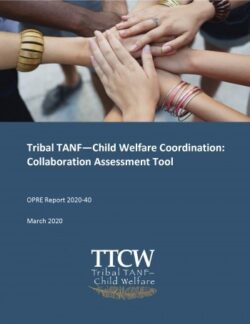Tribal TANF-Child Welfare Coordination: Collaboration Assessment Tool
- Authors:
- Kirsten Keene
- Erin Geary
- Pirkko Ahonen
This tool was developed to help current and future Tribal Temporary Assistance for Needy Families-Child Welfare Coordination grantees assess their initiatives’ partnership performance in a concrete and measurable way. It is intended to be used to identify areas of strength and areas in need of improvement as well as to track changes over time.
 Social service organizations and policy makers increasingly believe they can accomplish more and improve outcomes for those they serve when they work together with other organizations. They forge new partnerships, develop new relationships, and often implement changes to practice as a result of collaboration and coordination efforts.
Social service organizations and policy makers increasingly believe they can accomplish more and improve outcomes for those they serve when they work together with other organizations. They forge new partnerships, develop new relationships, and often implement changes to practice as a result of collaboration and coordination efforts.
Collaboration and coordination efforts occur along a continuum, from early planning stages towards more fully developed or mature levels of partnership. Taking a periodic assessment of the level at which partnerships are operating can help organizations take steps to intensify and strengthen their partnerships, and identify priority areas to focus their improvements.
The Collaboration Assessment Tool is a resource for Tribal TANF-Child Welfare Coordination grantees and other partnering human services programs to help them identify and operationalize various collaboration constructs, monitor collaboration efforts, and measure and track progress on collaboration and coordination. Detailed instructions are provided on options for completing, scoring, and interpreting the results of the tool.
The tool assesses progress in eight areas or categories of indicators:
- Relationships and communication
- Information sharing
- Staff training
- Screening and assessment
- Case planning and case management
- Coordinated delivery of services
- Information systems
- Additional indicators

